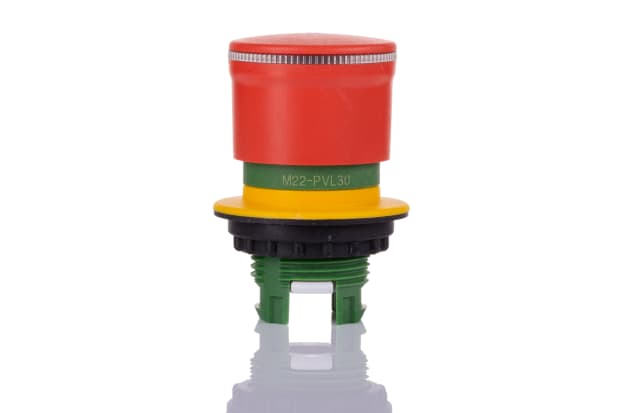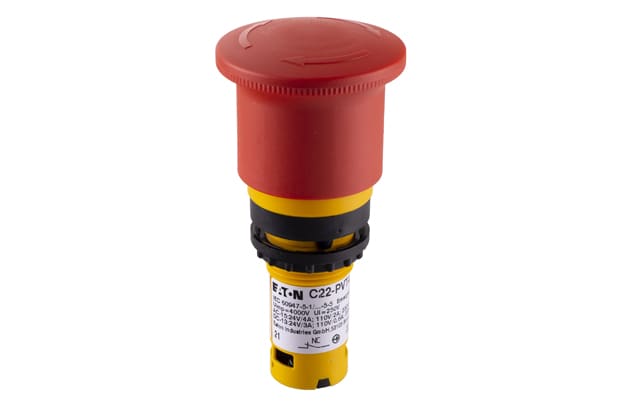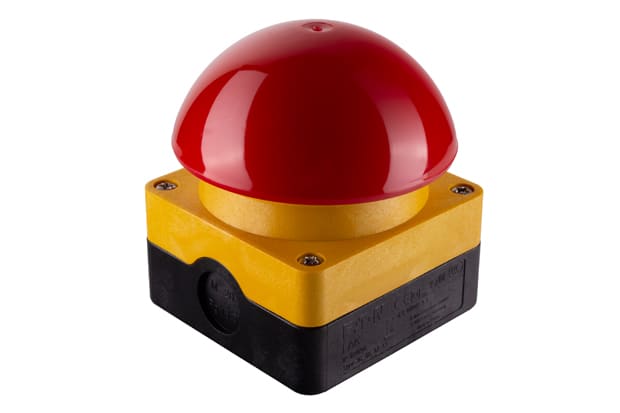- Published 15 Nov 2022
- Last Modified 29 Aug 2023
- 8 min
The Ultimate Guide to Emergency Stop Buttons by Eaton
Emergency stop buttons are key for employee and machine safety. Discover all you need to know about e-stops in this handy guide from RS and Eaton.

Emergency Stop Buttons Explained
Emergency stop buttons are a key contributor to employee and machine safety. Some countries and types of machinery are also legally required to provide an emergency stop function. Choosing the right emergency stop button is critical. That’s why we have partnered with Eaton, a global leader in manufacturing E-Stop solutions, to bring you this guide.
What is the Emergency Stop Button?
Emergency stop buttons, also known as E-Stops or kill switches, are used to reduce the risk of injury by stopping machinery quickly.
Emergency stop buttons are fitted for easy access in any emergency. E-Stops are red and must feature a yellow background, bezel, or housing for attention. The button is designed to be operated easily, even with gloves. They may also light up for use in darker environments.
There is a range of emergency stop buttons available for different applications. Stop/Off buttons are also available for non-emergency use. These are typically black buttons instead.
Choosing an Eaton emergency stop button ensures optimum safety and versatility. Eaton offers a wide range of buttons for most common applications and environments.
How Do Emergency Stop Buttons Work?
Emergency stop buttons essentially break an electrical circuit to prevent power from passing through. This causes the machinery to stop functioning immediately. Some emergency stop buttons may connect to a controller if the power must be stopped differently.
E-stop buttons are designed to be easy to use, to avoid any confusion in high-pressure situations. E-stop colours are bright and instantly recognisable, while the button itself is shaped for easy use.
Types of Emergency Stop Buttons
Eaton RMQ Small E-Stop

The Small Emergency Stop Button
Eaton’s range of RMQ small e-stops combine quality, safety, and functionality into a compact design. This is the perfect choice for applications where space may be limited, but you require the same level of safety. This sleek design is available in a range of colours and reset methods, for a wide range of applications.
Explore Eaton RMQ Small E-Stop
Get to know the RMQ small emergency stop button with this handy video from Eaton.
Features of the RMQ Small E-Stops:
- Illumination – increasing the visibility of your e-stop is always best. The RMQ range offers light-up options for simple illumination or indication of the machine status. They feature a 360° ring light around the button to ensure visibility from every angle. Even more impressive, the RGB LED inside allows you to choose from up to 7 colours
- Durable – Some RMQ small e-stops are rated to IP69, meaning they can withstand almost any condition. IP69 represents a very high level of protection. It is protected from both dust and high-pressure water. This is perfect for harsh environments or machinery which will require regular sanitisation. IP65 options are also available
- Compact – sitting at approximately 30% smaller than standard push buttons, the RMQ small e-stops combine everything you need into a much smaller package. The emergency stop button comes in 22mm and 30mm diameter options
- Flexible – The RMQ small e-stop is compatible with the entire Eaton range, including the other RMQ products, therefore it is easy to incorporate these into your designs. They also offer one-hand assembly
RMQ Small E-Stop Variations:
- Release methods – turn-to-release or pull-to-release
- Illumination – with or without light-up 360° ring or illuminated lens
- Diameter – 20mm or 30mm
- Colour – red (emergency) or black (on/off)
Installing Emergency Stop Buttons
The physical placement of your emergency stop button is important to consider. It must be installed in a location which is obvious and easy to reach.
When it comes to wiring your emergency stop button, it will sit within an electrical circuit to allow the current to pass through the button. It will usually be before the control breaker and after the standard on/off switches.
Emergency stop buttons are usually used with two NO (normally open) contacts. They are used to unlatch the control relays. For further signalling reasons, you can attach additional NC (normally closed) contacts. NC and NO refer to the contact configuration and are something to consider when choosing your button.
- NC (normally closed) contacts are closed, and they open on operation
- NO (normally open) contacts are open, and they close on operation
Keep in mind...
For the emergency stop function, NC (normally closed) contacts need to be used.
Mounting E-Stops

Panel Mount
Panel mount emergency stop buttons are designed to be mounted within a larger panel. They require a hole or cut-out, typically 22mm or 30mm in diameter.
Panel mount buttons are better for more integrated designs. These emergency buttons can be included within the main control panel of the machine.

Surface Mount
Surface mount emergency stop buttons can be mounted directly onto machinery. This is a complete unit which often comes with yellow housing to help it stand out. Surface mount buttons can be placed in easy-to-reach locations for workers to access.
Resetting Emergency Stop Buttons
After activation, you will need to release the emergency stop button to return to normal operation. There are several methods by which this can happen:
- Pull to release – this is a common type of button which is simply pushed to activate. It is then pulled back outwards to release
- Twist to release – Similar to the push/pull, this button is pushed to activate. To release, the button is twisted
- Key release – this button is also pushed to activate but must be released using a key. The key is often inserted into the head of the button. The key release is ideal for ensuring authorised operation in high-risk environments
FAQs
Where are emergency stop buttons used?
Emergency stop push buttons are found in most industrial and commercial environments. They are used anywhere where you will find large machinery. E-stop buttons can also be found in public environments where there may be risks, for example, escalators and elevators.
When should an emergency stop button be used?
E-stop buttons are used to prevent accidents and harm. Therefore, if danger is suspected at any point, the emergency stop button is to be used. The button can also be used when the workflow is required to stop immediately.
What are the regulations for manufacturing/supplying machinery to the UK?
To ensure optimum safety, compliance with “The Supply of Machinery (Safety) Regulations 2008 No. 1597“ is essential.
Can I ship these products overseas?
It is always important to check the local requirements of your product. If you decide to ship your products overseas, pay attention to global certifications such as CE, UL, CSA and CCC.
Do emergency stops need to be labelled?
It is not generally a requirement for e-stops to be labelled using text or imagery. Some guidance recommends avoiding text as the colour of the button is immediately identifiable. Wording can take longer to read and become confusing. It is always recommended to check the requirements for your application and country.
What is the difference between a stop button and an emergency stop button?
Standard stop buttons are used alongside a start button for typical machine operation. They are usually black and can be placed amongst other functions on a control panel. Emergency stop buttons are designed to stand out and should only be used in emergencies. They should not be installed close to standard buttons as this may cause confusion.
Which standards should my emergency stop button meet?
Standards will vary per country. For the UK, you can refer to EN ISO 13850:2015 for information on e-stop functional requirements and design features.
Can emergency stop buttons be covered?
No, it is recommended that you do not cover your emergency stop button. They are required to be quickly and easily accessible in an emergency. It would require multiple actions to operate which would delay an emergency and potentially cause additional risk.
Related Guides
Related links
- Emergency Stop Push Buttons
- Schneider Electric Emergency Stop Buttons
- Eaton Emergency Stop Buttons
- ABB Panel Mount Emergency Stop Push Buttons
- ABB Emergency Stop Push Buttons
- Schneider Electric Harmony XB4 Series Twist Release Emergency Stop...
- Siemens Backing Plate for Use with Emergency Stop Mushroom Push...
- EAO Legend Plate for Use with Push Button, Emergency Stop